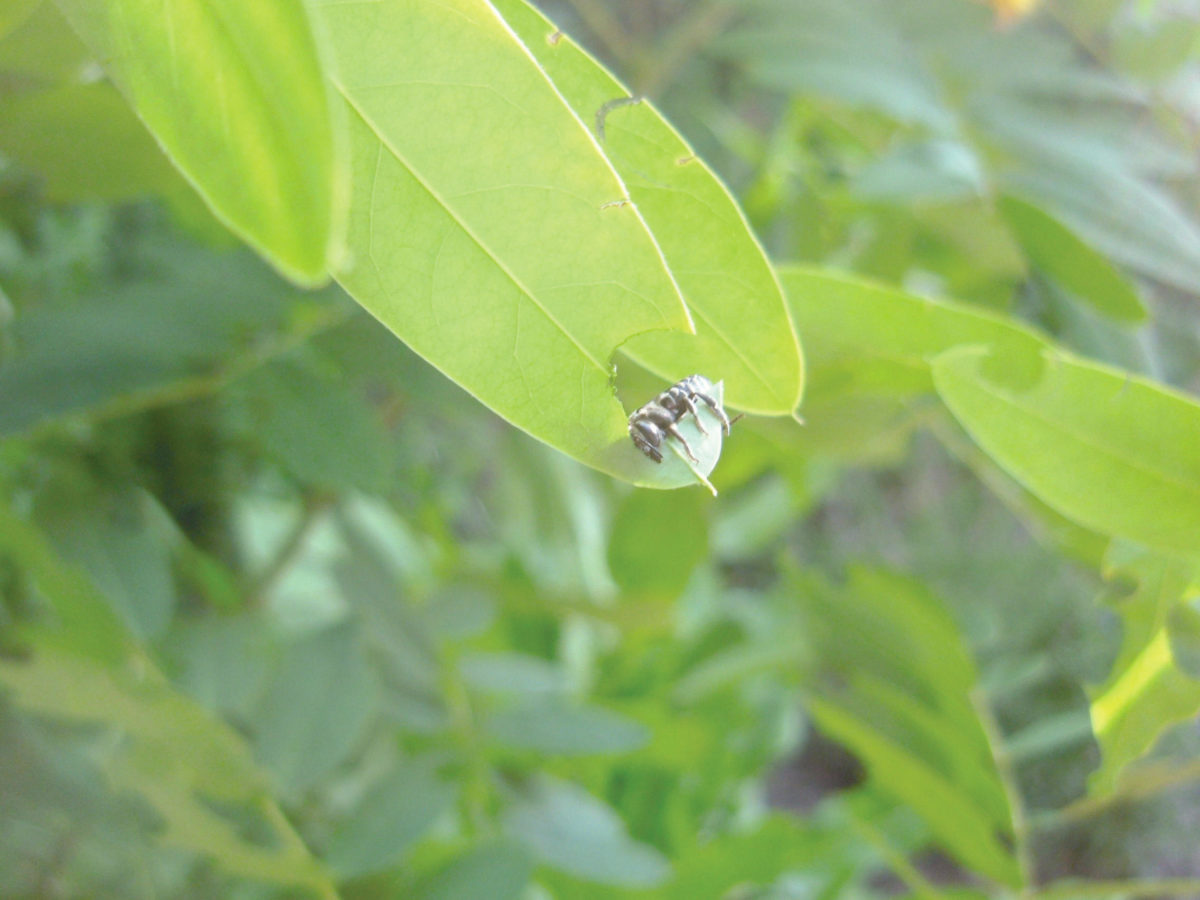
In nature, leafcutter bees nest in cavities like tunnels made by wood-boring insects. The absence of abundant and secure nesting sites limits the size of wild populations. Artificial nests can be constructed with blocks of wood or Styrofoam drilled with multiple holes, bundles of paper straws, or even sections of reed or bamboo to increase their population.
When searching for a suitable nest site, a female bee will repeatedly enter and inspect numerous cavities. Tunnel depth, diameter, and material all influence the appeal of the nests to female bees, as well as the ratio of male to female eggs that she will lay.
After selecting a nest hole, the bee will then fly in a zigzag pattern in front of the nest entrance, memorizing its exact location. During this orientation flight, the bee memorizes adjacent visual landmarks which help her to relocate the nest later. After memorizing the location, the nest cannot be moved without disorienting the bee, often causing her to completely abandon the nest.
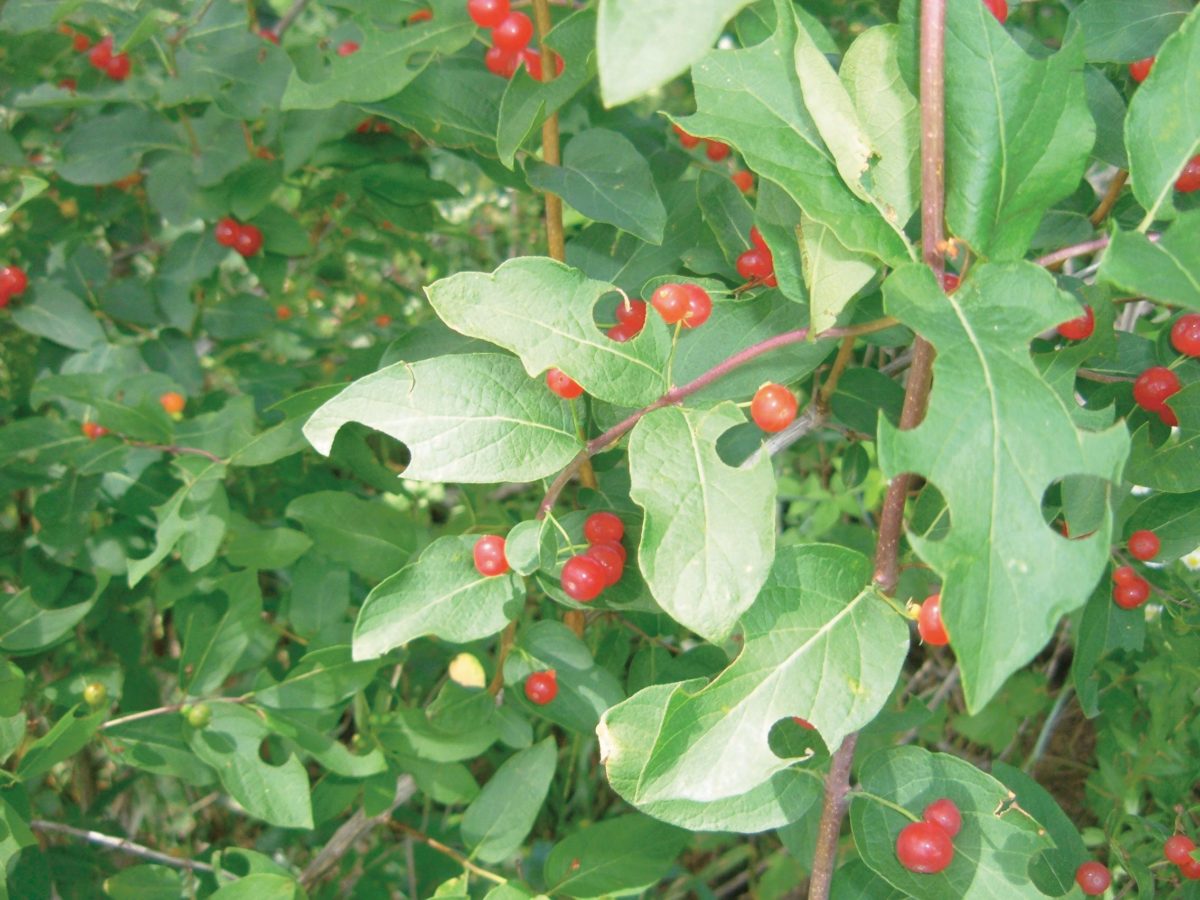
After memorizing the tunnel, the bee will then fly off in search of suitable leaf material from which to begin construction. Leafcutter bees prefer soft, flexible leaves for nest construction, such as alfalfa leaves and flower petals, clover, buckwheat, roses, lamb’s-quarters, and numerous other plants (Figure 7.4). Upon finding a suitable leaf, the bee will cut out a semicircular section from the leaf edge (Figure 7.5) with her scissor-like mandibles, resuming flight at the exact moment she finishes cutting out the leaf section. The bee then flies back to the nest with the leaf section held between her legs (Figure 7.6). The leaf section may weigh close to one-fourth the weight of the bee herself.
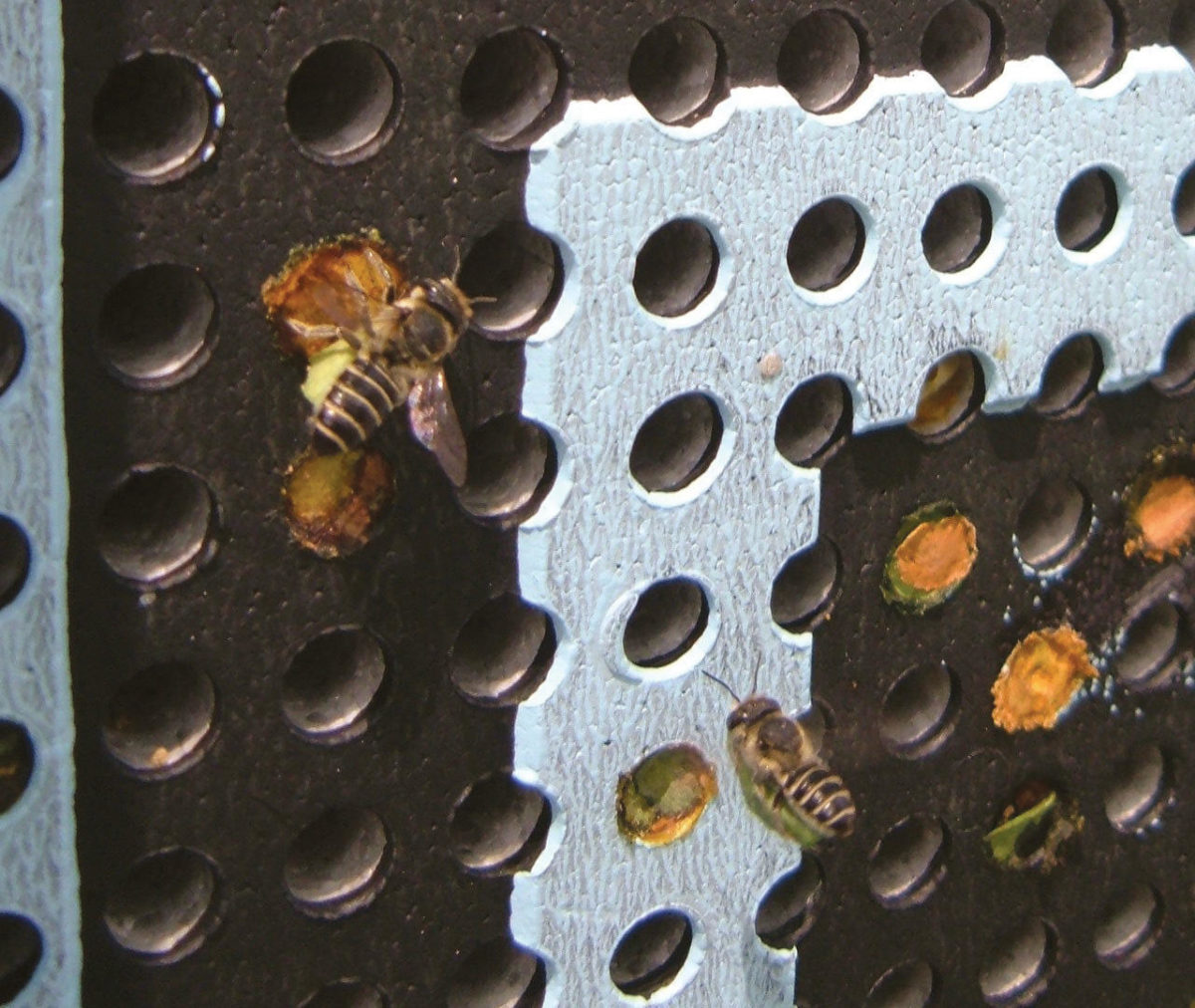
Back at the nest, the leaf piece is transferred to the mandibles as it is carried to the back of the tunnel. Several other half-circle shaped pieces will then be gathered and placed in the back of the tunnel in overlapping layers, creating a cup-shaped concave cell cemented together with salivary secretions and leaf resins. In commercially available nests, 15/64 to 1⁄4 inch in diameter, (~6 to 6.4 millimeters), roughly 15 leaf pieces are required to construct this initial cell. Within this cell the female bee will deposit a provision of pollen and nectar upon which she will lay an egg. The female will then close off the open end of the cell with two or three additional leaf pieces.
In gathering provisions for the nest, the female bee collects pollen which gets trapped among the hairs covering her body. Periodically while foraging, she will groom herself, transferring pollen from the front of her body backward with her forelegs, to the middle legs, and finally to the hind legs which scrape the pollen onto the scopa—the rows of long stiff hairs on the base of the abdomen that hold the pollen granules during the flight back to the nest. The bee also collects nectar while foraging by sticking her tongue into the corolla of flowers and sucking the nectar into her crop, or “honey stomach.” Upon returning to the nest the bee will enter headfirst and regurgitate the nectar at the back of the cell. She will then somersault inside the nest if there is sufficient room, or she will back out of the nest, turn around and back in. She then scrapes the pollen from her scopa using her back legs and tamps the pollen-nectar paste into position using the tip of her abdomen (see sidebar).
Alfalfa Pollination
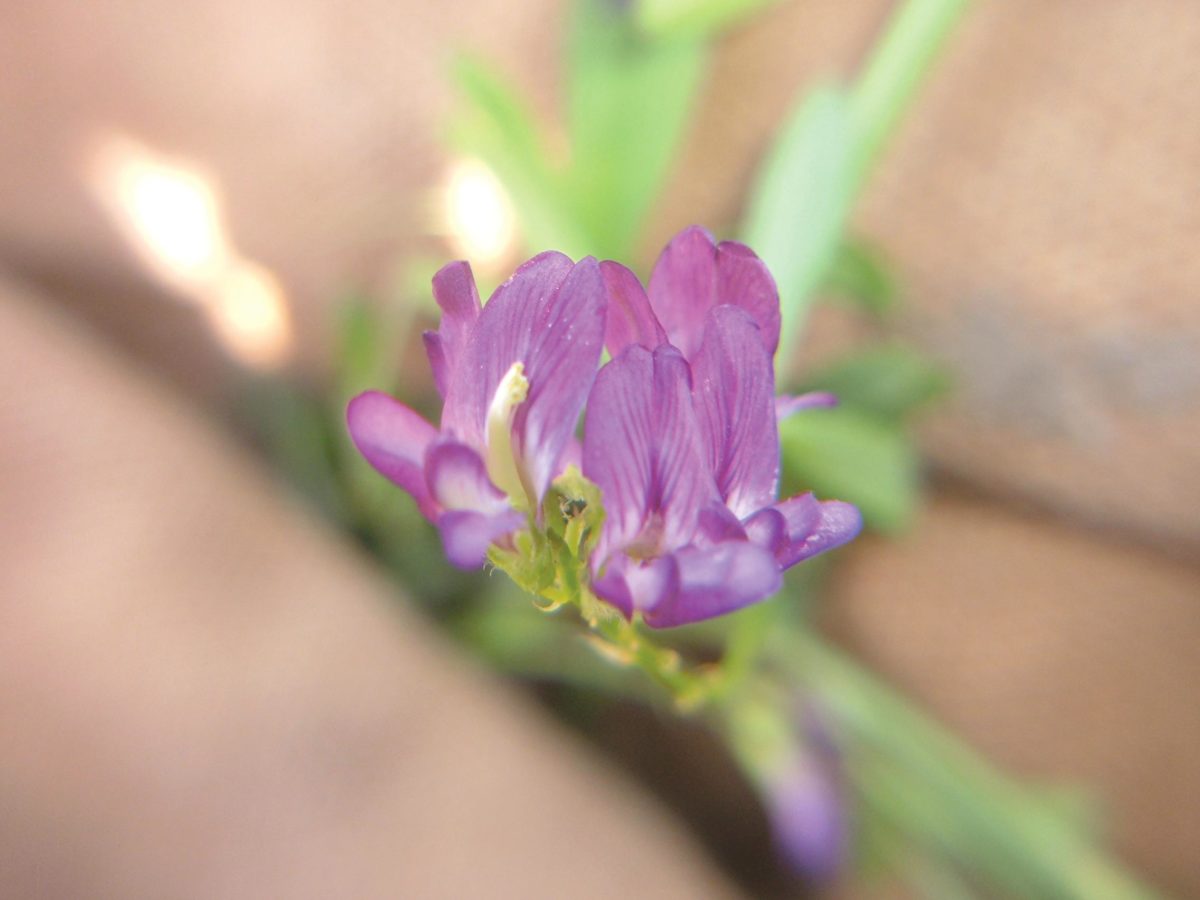
Alfalfa has an unusual flower for which the alfalfa leafcutter bee is especially well adapted. Like many other legumes, an alfalfa flower consists of one large “standard” petal, two “wing” petals on the sides of the flower, and two fused bottom petals which are called the keel (for their resemblance to a boat keel).
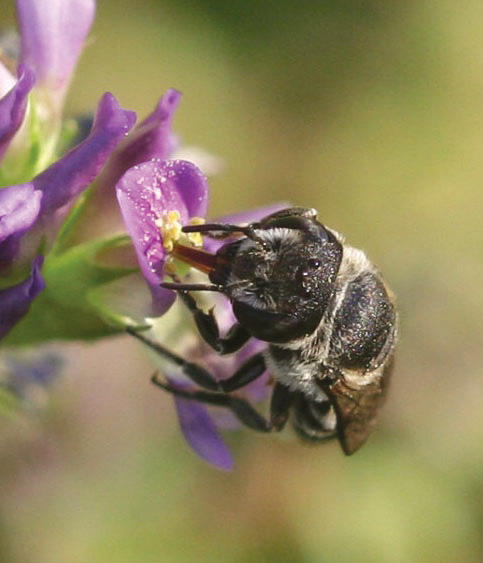
The keel petals enclose the stamen column under tension. When these fused petals are slightly separated by an insect probing the flower, the column is released, springing forward and slamming into the standard petal. Once released, or “tripped,” the stamen column does not return to its former position. Only after tripping can successful pollination occur (Figure 7.7)
During tripping, the bee is often struck on the head by the stamen column with a great deal of force, and dusted with pollen in the process (Figure 7.8). Honey bees often learn to avoid alfalfa flowers because of this tripping action and seek out easier food sources as a result. The alfalfa leafcutter bee, along with the alkali bee (Nomia melanderi), and various wild bees, are less deterred by this tripping action and are the chief pollinators of alfalfa flowers.
In addition to alfalfa, the leafcutter bee has been successfully used as a managed pollinator of canola, cranberries, blueberries, and various vegetable crops such as seed carrots.
A total of 15 to 30 trips may be required to gather the necessary pollen and nectar to provision one cell. Initially the mother bee will collect more pollen than nectar, later increasing the amount of nectar collected until the final ration consists of around two thirds nectar to one-third pollen. Like the leaf pieces from which she constructs the nest cell, these pollen provisions can weigh almost a quarter of the bee’s total body weight. Under warm, clear conditions with unlimited forage, a bee may visit up to 25 flowers a minute and complete a single cell in five hours.
Prior to closing off the cell, the mother bee lays an egg which is inserted into the pollen-nectar paste. After closing this cell, she will then immediately begin construction of a second cell, repeating the process until the entire tunnel is almost filled. Depending on the length of the tunnel, 8 to 12 cells may be constructed in a single cavity. When the tunnel is nearly filled with cells, the bee will then collect 10 to 50 circular pieces of leaf which are deposited individually into the nest entrance. These circular pieces are cemented together forming a solid plug which is flush with the hole entrance (Figure 7.9). This plug serves as a barrier against rain, predators, and parasites.
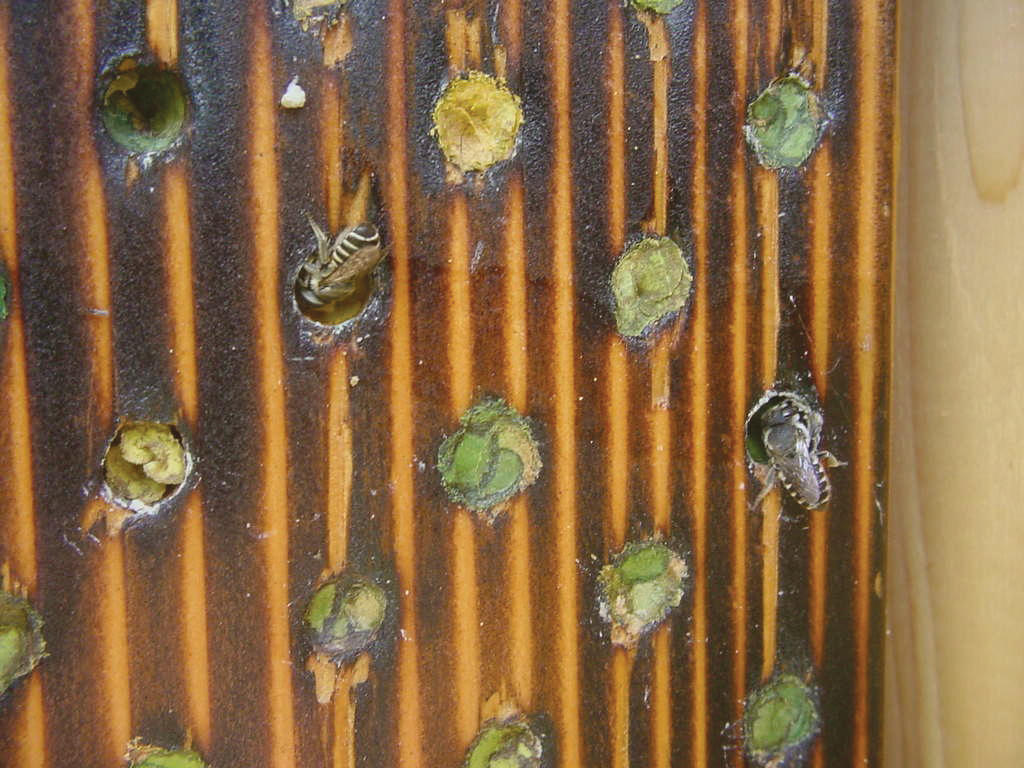
Under favorable conditions a female bee may finish two to four tunnels in her lifetime, with a rough average of around 30 eggs—although 50 or more eggs have been documented in some cases. Of course during this nesting period the bee is exposed to predation by birds, insects, and other animals, inclement weather, pesticides, and a host of other conditions that can halt nesting activities at any moment. Female bees spend the evening inside the nest, face inwards. Under overcast conditions, during rain, or when temperatures drop below 64°F (17.8°C), females will remain inside the nest facing outward, guarding against intrusion by other insects.
Mated female bees store sperm in a specialized organ called the spermatheca. The spermatheca allows the mother bee to determine the sex of her offspring by either fertilizing an egg, resulting in a female offspring—or not fertilizing an egg, resulting in a male offspring. Female nest cells are larger and are provisioned with more food. Normally female eggs are laid in the innermost cells, and male eggs are laid in the outermost cells closest to the entrance where parasite and predation rates may be higher because they are more expendable. Sex ratio is determined in large part by the depth and diameter of the nest cavity, with deeper tunnels favoring the production of more female bees. Under optimal conditions, sex ratios should be close to 1.5 to 2 males per female. Many commercially available leafcutter nests favor higher male bee ratios.
Development time for the bee larvae is temperature dependent (Figure 7.10). At 60°F (15.6°C) it takes 15 days for the eggs to hatch and 35 days for the larvae to reach the prepupal stage. At 95°F (35°C) it takes only two or three days for eggs to hatch and eleven days to reach the prepupal stage. The larvae develop through four growth stages called “instars” with rapid increases in size at each stage. High mortality levels can occur during the first or second instar as a result of nest temperatures above 80°F (26.7°C), or from cold periods that prevent feeding. Larvae that die at this stage result in empty pollenfilled cells, called “pollen balls.”
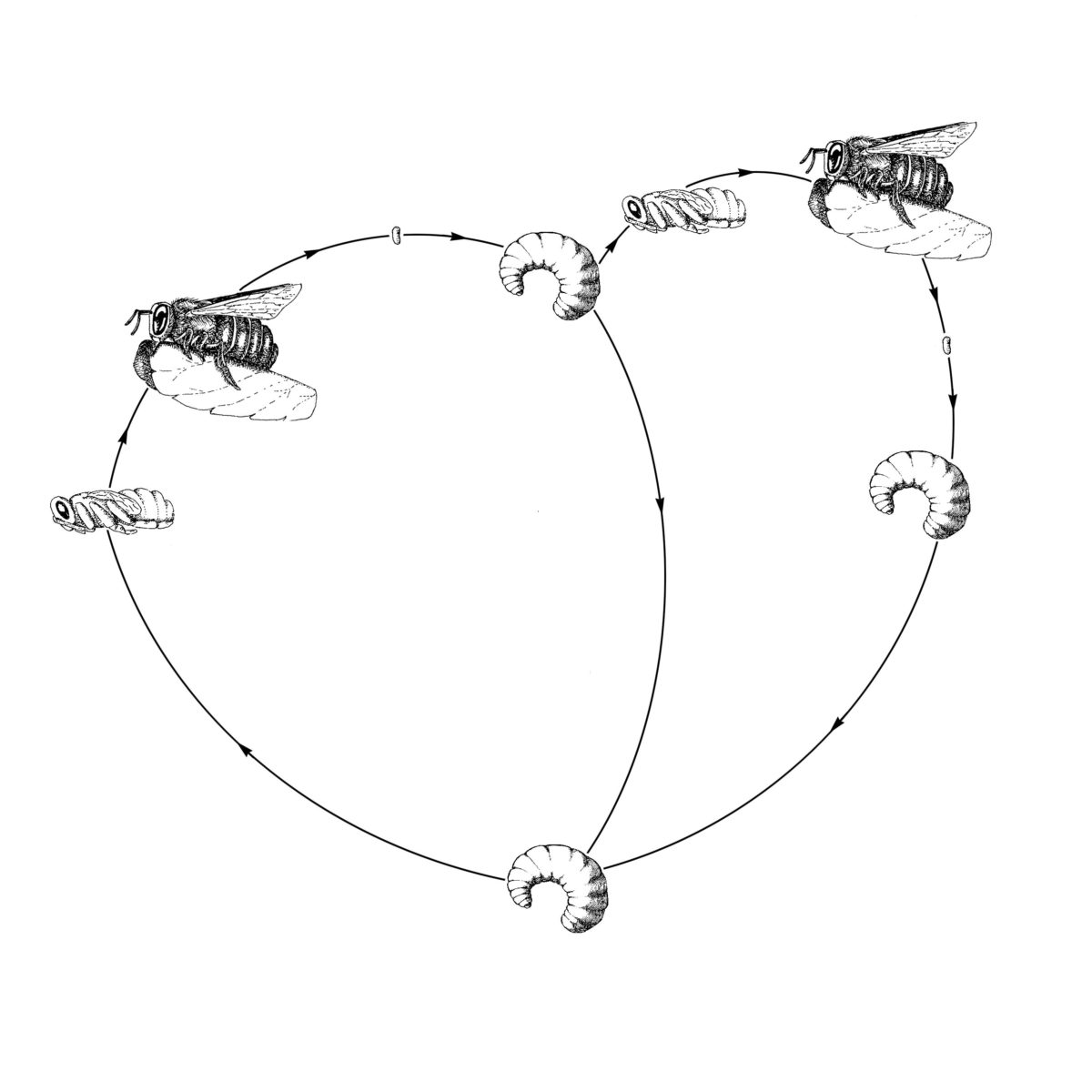
In early instars the larva may move around inside its cell; however, the head remains in contact with the food provision. By the fourth instar the larva will have eaten all of the food provision in the cell. It will then defecate and spin a tough silk cocoon produced by its salivary glands. During the cocoon spinning process, the larva will turn completely around inside the cell so that the head ends up facing the nest entrance. In northern climates, development will then cease, and the bee will overwinter in this dormant prepupal stage. Managed bees are often placed into cold storage at this stage of development and held until the following season.
In northern climates, during the following spring or early summer as temperatures warm, these prepupae again molt into pupae. In southern climates, development may continue uninterrupted resulting in a second generation of bees (see sidebar). In either case, pupae resemble adult bees, except they are completely white in color. Over several days, the eyes of these pupae darken, and the bodies become gray-black in color. Roughly one week after changing color the first male bees emerge by chewing their way out of the nest cells. Male emergence always precedes female emergence, and usually at least 50 percent of all male bees will have emerged prior to the first female appearing.
Mating occurs near the nest from which the bees emerged, with male bees pouncing on the backs of newly emerged females. If the female bee is receptive, she will raise the tip of her abdomen and invert her stinger, allowing coupling. Mating lasts less than a minute, and female bees normally only mate once, although male bees may mate repeatedly. Sperm is retained in the spermatheca while the ovaries mature. Within one to two days, the female is ready to lay eggs. During this period she will feed on nectar and find and orient to a suitable nest tunnel.
Female bees prefer to nest near sites from which they themselves emerged, although not necessarily in the same cavity. Following mating some female bees will abscond from the area, in a process referred to as pre-nesting dispersal. As a general rule, the more appealing the nest site, the fewer females will disperse prior to nesting.
Second-Generation Bees
In northern climates like the prairie provinces of Canada, only one generation of bees is normally produced per season. However, in much of the US, especially in warm years, a significant percentage of the developing bee larvae can fail to diapause (enter dormancy).
This is particularly true of cells which are completed in the early part of the season and can result in emerging adult bees twenty-some days after the time the eggs were laid. In eastern Washington state for example, up to 90 percent of the eggs laid in June may result in second-generation bees. Of eggs laid after mid-July, only 50 percent may develop into second-generation bees, and of eggs laid in August, few second-generation bees will normally emerge.
Second-generation bees are a problem in leafcutter production for several reasons. First, second-generation bees often have less available forage, produce fewer cells, and their larvae must develop late in the season—often under conditions which are too cold for the larvae to feed.
The other problem with second-generation bees is a larger incidence of chalkbrood mortality. As second-generation bees emerge directly from the nest, they chew through any chalkbrood-contaminated cadavers and become covered with chalkbrood spores in the process. These second-generation bees then return to nest and contaminate any new cells they produce.
There have been attempts to control second-generation bees through breeding programs that select for lines of bees that produce only one generation of bees per year. These programs used leafcutter bees imported from southern Europe, and were highly successful. Unfortunately these breeding programs have not been well supported and there is little continuing research into breeding or maintaining these lines of bees.
Limited control of second-generation bees can be achieved by the producer through a variety of practices. Among these is delayed incubation whenever possible to result in later-emerging bees. In addition, nests should be monitored closely and removed from the field when more than 75 percent of the tunnels are capped. These nests should be maintained at around 70°F (~21°C) for about 15 days to allow larvae to finish feeding and develop into the prepupal stage. The nests should then be gradually cooled in a walk-in cooler or air conditioned location to simulate the approach of winter.
